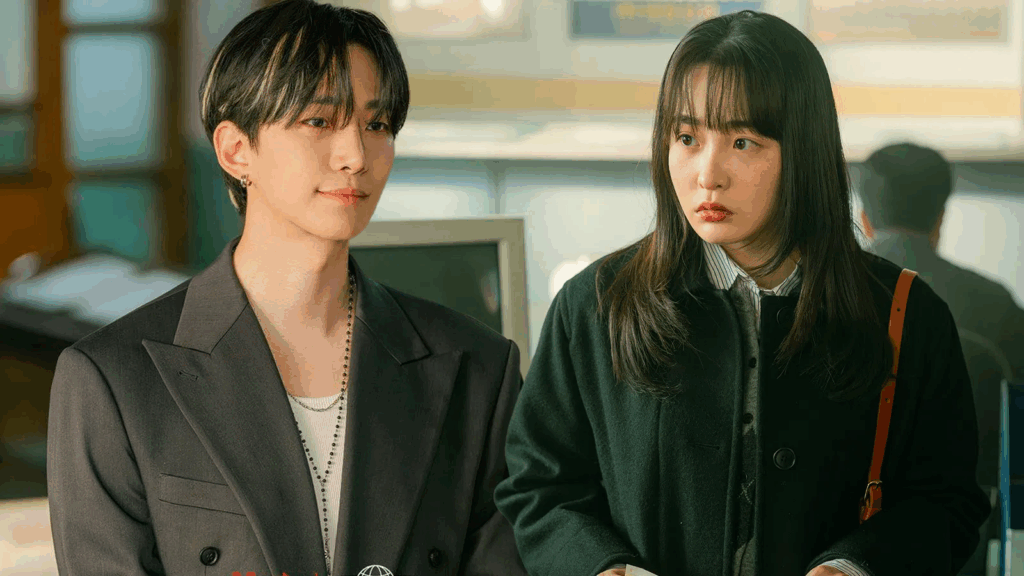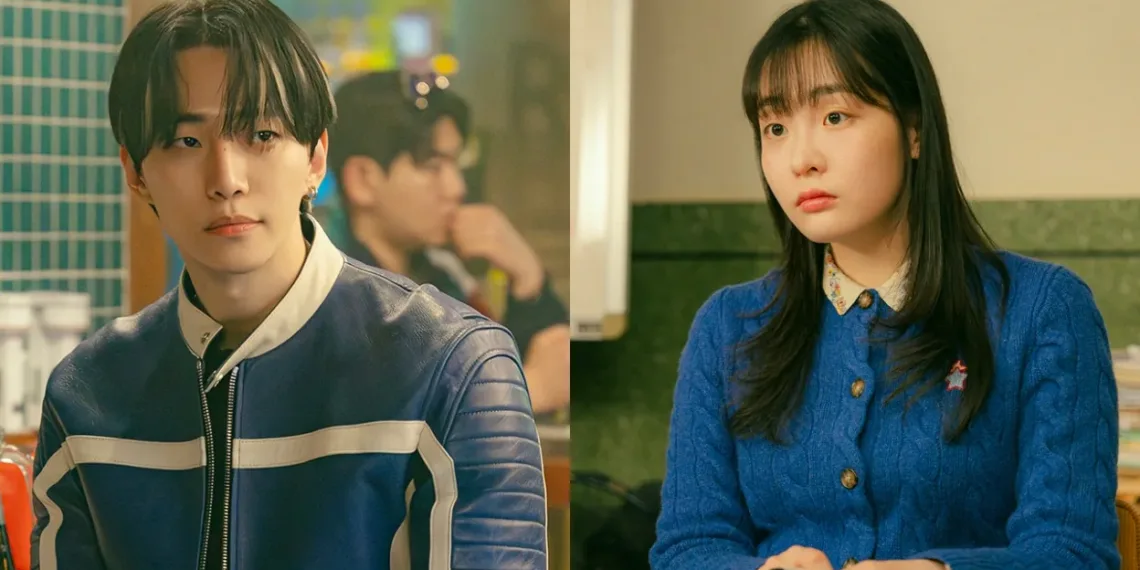The romantic tension on tvN’s Typhoon Family just reached new heights. Lee Junho and Kim Min Ha are returning to the subway—the very place where their characters first met—for another butterflies-inducing scene that’s guaranteed to have viewers reaching for their fans. As Kang Tae Poong protectively shields Oh Mi Seon in a crowded subway car, their close physical proximity creates the kind of romantic chemistry that K-drama fans live for.
Table of Contents
Typhoon Family: Drama Facts
| Category | Details |
|---|---|
| Drama Title | Typhoon Family |
| Network | tvN |
| Air Date | November 9, 2025 at 9:10 PM KST |
| Lead Actors | Lee Junho (2PM), Kim Min Ha |
| Characters | Kang Tae Poong & Oh Mi Seon |
| Setting | 1997 IMF Crisis in South Korea |
| Genre | Romance, Business, Period Drama |
| Episode Focus | Subway romantic tension scene |
Lee Junho: From 2PM Idol to K-Drama Heartthrob
The Actor’s Journey: Lee Junho, member of the legendary K-pop group 2PM, has successfully transitioned from idol to critically acclaimed actor. His transformation from stage performer to dramatic actor showcases his dedication to craft over celebrity status.
Character Deep Dive: In Typhoon Family, Junho portrays Kang Tae Poong, a carefree party boy whose comfortable life is upended when he’s suddenly thrust into leading a struggling trading company during South Korea’s devastating 1997 IMF crisis. This character allows Junho to showcase both comedic charm and emotional depth.

Previous Drama Success: Junho gained widespread recognition for his role in The Red Sleeve, where his portrayal of Crown Prince Lee San earned him Baeksang Arts Awards recognition. His ability to convey subtle emotions through minimal expressions makes him perfect for romantic period pieces.
The Protective Gesture: In the upcoming subway scene, Junho’s Tae Poong creates a protective barrier around Mi Seon in the crowded car, using his body to shield her from pressing passengers. This chivalrous act—common in K-dramas but executed with Junho’s trademark sincerity—demonstrates how Tae Poong’s feelings have evolved from casual flirtation to genuine care.
Why This Scene Matters: The subway setting brings their relationship full circle. Where they once were strangers stealing glances, they’re now CEO and employee navigating complicated romantic feelings while maintaining professional boundaries during a national economic crisis.
Kim Min Ha: The Rising Star Capturing Hearts
Background: Kim Min Ha emerged as one of K-drama’s most promising actresses through her breakout role in Pachinko, where she portrayed the young Sunja with remarkable emotional depth. Her ability to convey complex emotions with subtlety rather than melodrama has made her a sought-after leading lady.
Oh Mi Seon’s Character: Min Ha plays Oh Mi Seon, a character whose jealousy surfaced when a conglomerate heir’s daughter showed interest in Tae Poong. Her push-and-pull dynamic with Tae Poong—accepting his confession but rejecting his kiss attempt—showcases a woman navigating feelings while maintaining personal boundaries.
The Thailand Trip Evolution: During their business trip to Thailand, the bond between Tae Poong and Mi Seon deepened significantly. When Tae Poong cautiously leaned in for a kiss, Mi Seon’s response—”I don’t think now is the time for this”—revealed her inner conflict between desire and practicality.
Chemistry Factor: The stills from the subway scene show Min Ha’s expressive face capturing Mi Seon’s awareness of their proximity, creating that delicious tension K-drama fans crave. Her ability to communicate attraction and restraint simultaneously makes every interaction electric.
Career Trajectory: Following Pachinko and Way Back Love, Typhoon Family positions Min Ha as a versatile actress comfortable in both period settings and contemporary roles. Her pairing with established actor Junho demonstrates industry confidence in her star power.
The Symbolic Subway Setting
First Meeting Callback: The production team emphasized the significance: “During their first meeting, they didn’t know one another, but they are now commuting to work together as Typhoon Trading’s CEO and employee.” This parallel structure creates narrative symmetry that K-drama viewers appreciate.
Romantic Tension Device: Crowded subways are K-drama gold for forced proximity scenarios. The packed environment creates legitimate reasons for characters to get physically close, allowing romantic tension to build naturally rather than through contrived circumstances.
1997 Historical Context: The subway setting grounds the drama in its 1997 IMF crisis timeframe, when many South Koreans relied on public transportation. This authentic detail enriches the period drama atmosphere.

What Happened Previously
The Confession: Tae Poong boldly confessed his feelings to Mi Seon, showing his character’s direct approach to romance.
The Jealousy: Mi Seon’s jealous reaction to another woman’s interest confirmed her own feelings, even as she maintained emotional distance.
The Rejected Kiss: Mi Seon pushing Tae Poong away despite their deepening bond during the Thailand trip created unresolved sexual tension that this subway scene will undoubtedly amplify.
The Production Tease: “The subtle emotions between the two of them as they get closer amidst the packed crowd will create romantic tension and make viewers’ hearts flutter,” the production team promised—and if the stills are any indication, they’re delivering on that promise.
For more K-drama updates, episode previews, and behind-the-scenes content, visit technosports.co.in for comprehensive entertainment coverage.
Why This Scene Will Break the Internet
The combination of Junho’s protective masculine energy, Min Ha’s conflicted feminine longing, the intimate forced proximity, and the callback to their first meeting creates a perfect storm of romantic tension. Add in the 1997 period setting’s nostalgic appeal and the business-romance genre’s inherent drama, and you have a scene destined for Twitter trends and YouTube reaction videos.
FAQs
What is the IMF crisis context in Typhoon Family?
Typhoon Family is set during South Korea’s 1997 IMF crisis, one of the most traumatic economic periods in modern Korean history. The Asian financial crisis forced South Korea to accept a $58 billion bailout from the International Monetary Fund, leading to massive unemployment, business failures, and social upheaval. The drama uses this historical backdrop to add stakes to Kang Tae Poong’s sudden responsibility of leading a struggling trading company—he’s not just dealing with personal growth but national economic catastrophe. This context makes the romantic subplot more poignant; amid national crisis, Tae Poong and Mi Seon finding connection and hope through each other becomes symbolically powerful. The period setting also allows for authentic storytelling about class differences, business ethics, and resilience that resonate with contemporary audiences.
Will Lee Junho and Kim Min Ha’s characters end up together in Typhoon Family?
While the production hasn’t revealed the ending, the romantic trajectory suggests Tae Poong and Mi Seon are heading toward a relationship, though obstacles remain. Mi Seon’s rejection of Tae Poong’s kiss with “I don’t think now is the time” indicates she has feelings but faces barriers—possibly professional boundaries (CEO and employee), timing concerns during the crisis, or personal reservations. K-dramas typically feature separation before ultimate reunion, so expect more push-and-pull before any definitive romantic resolution. The subway scene’s intimacy signals progress in their relationship, but the business/economic crisis backdrop likely creates additional complications. Given both actors’ chemistry and the show’s romantic genre classification, a happy ending seems probable, though the journey there will undoubtedly include heartbreak, misunderstandings, and dramatic tension that keeps viewers emotionally invested.








